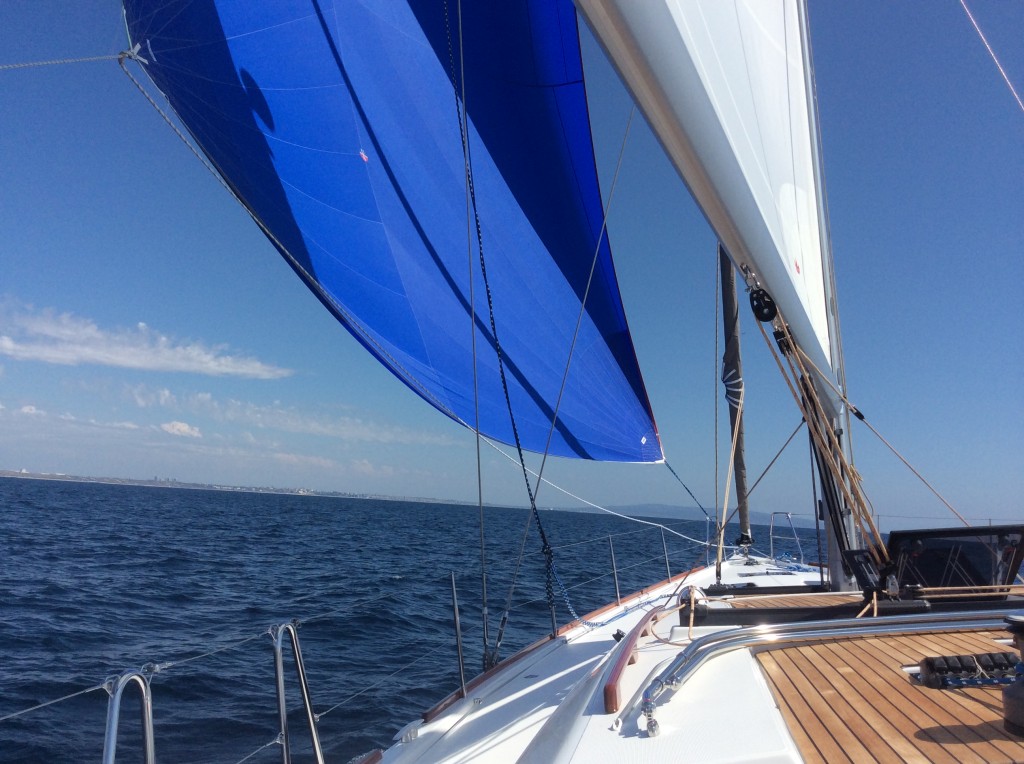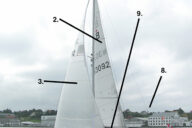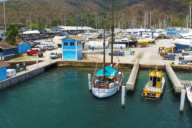Here’s a great article by Quantum’s Dave Flynn on what you need to know about downwind sails before talking to your sailmaker…
With a little luck and patient scheduling, the majority of extended cruising miles should feature plenty of off the wind work. While standard working sails are fine when the wind is forward of the beam, they are less than ideal at wind angles greater than 90 degrees apparent. Small size, heavy construction and the fact that they get blanketed behind the mainsail, make them less than ideal tools for the job. Fortunately, cruising sails to optimize downwind performance have come a long way in the last decade or so, and cruising sailors now have a range of options. Let’s take a look.
Since time immemorial, the classic approach has been to add a “cruising spinnaker.” But what is a cruising spinnaker? Traditionally it was a relatively heavy nylon sail (usually 1.5oz), with a foot length between 1.65 and 1.8 of the “J” (fore triangle length from base of mast to forestay), and a mid-girth (width halfway up the sail) of 90-95% of the foot length. Shaping was pretty much like a symmetrical spinnaker with the leech shortened so that the sail had a distinct luff and leech and was designed for the tack to be set at a fixed point on the bow. This got rid of the pole, and voila, the asymmetric spinnaker.
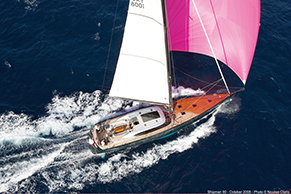 The modern world of “asymmetric” spinnaker design opens up a range of options. Sizing and shaping have become much more sophisticated. The basic concept is this; a spinnaker that is larger and has more shape is better at broad angles. A sail that is smaller and flatter is happier at close angles. Everything in between is possible. The mid-girth measurement is a key guide. A running sail will have a mid-girth equal to or even greater than the foot; a moderate reacher maybe 90 percent; and a Code Zero 60 to 70 percent. To support girth you must add depth or the sail will just flutter, so bigger equals deeper.
The modern world of “asymmetric” spinnaker design opens up a range of options. Sizing and shaping have become much more sophisticated. The basic concept is this; a spinnaker that is larger and has more shape is better at broad angles. A sail that is smaller and flatter is happier at close angles. Everything in between is possible. The mid-girth measurement is a key guide. A running sail will have a mid-girth equal to or even greater than the foot; a moderate reacher maybe 90 percent; and a Code Zero 60 to 70 percent. To support girth you must add depth or the sail will just flutter, so bigger equals deeper.
 The other design issue is how the area is balanced between luff and leech, and specifically how much is placed forward of the straight line luff. Asymmetrics for running have plenty of positive area forward of the straight luff which can rotate around to weather of the centerline when the sheet is eased and allow the sail to project from behind the mainsail. Optimize the sail for closer reaching angles and this area is reduced. A Code Zero or Screacher (multihull version of the Zero) might have virtually none and will be essentially straight or even hollow like a genoa.
The other design issue is how the area is balanced between luff and leech, and specifically how much is placed forward of the straight line luff. Asymmetrics for running have plenty of positive area forward of the straight luff which can rotate around to weather of the centerline when the sheet is eased and allow the sail to project from behind the mainsail. Optimize the sail for closer reaching angles and this area is reduced. A Code Zero or Screacher (multihull version of the Zero) might have virtually none and will be essentially straight or even hollow like a genoa.
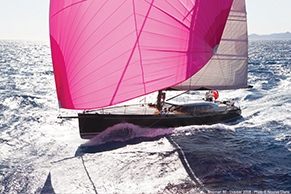 There is also the simple issue of size. On a cutter with a big fore triangle (“J”), using 180% as a multiplier to determine foot length gets you a big sail—maybe too big to handle conveniently. Conversely, on a boat with a small “J” (fractional rigs and modern mastheads) the bigger multiplier may be required to give the sail enough power to be worth it. Many cruising boats are adding bowsprits, which open up options even farther. With a sprit, the only limitation on size might be the “aspect ratio,” or height versus width. Usually you don’t want to get too tall and skinny, or too wide and stubby. A balance is important to the sail’s performance.
There is also the simple issue of size. On a cutter with a big fore triangle (“J”), using 180% as a multiplier to determine foot length gets you a big sail—maybe too big to handle conveniently. Conversely, on a boat with a small “J” (fractional rigs and modern mastheads) the bigger multiplier may be required to give the sail enough power to be worth it. Many cruising boats are adding bowsprits, which open up options even farther. With a sprit, the only limitation on size might be the “aspect ratio,” or height versus width. Usually you don’t want to get too tall and skinny, or too wide and stubby. A balance is important to the sail’s performance.
Another consideration is boat speed. The higher the speeds a boat is capable of, the farther forward it pulls the apparent wind. Longer boats go faster. Some modern designs, especially on the cruising multihull side of the equation, are getting quite fast. This means that smaller, flatter designs will work well. On a typical moderate displacement design of medium size, the apparent wind angles are usually wider, so there is more need for bigger and fuller.
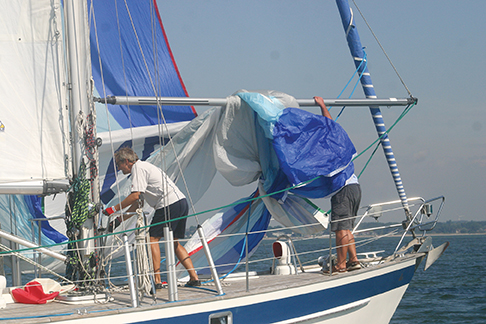 Finally, what does the rest of the inventory look like? If a big, overlapping genoa is the primary working headsail, then closer reaching angles up to a beam reach and even a little aft will be covered. If the primary working sail is a small, non-overlapping jib or self-tacker, the boat is going to need help as soon as the sheets are eased.
Finally, what does the rest of the inventory look like? If a big, overlapping genoa is the primary working headsail, then closer reaching angles up to a beam reach and even a little aft will be covered. If the primary working sail is a small, non-overlapping jib or self-tacker, the boat is going to need help as soon as the sheets are eased.
So, what flavor do we need? Well, there is no free lunch. It comes down to the apparent wind angle you want optimize for. Most cruising sailors want simplicity and one sail to do it all.
The middle road means apparent wind angles of 80 to 40 degrees and moderate overall size, keeping in mind the size of the “J.” The girth will be in the range of 90 to 95 percent with moderate depth and projection forward of the straight line luff. This is what in many sailmakers’ vernacular is an “A3” all-purpose reaching sail.
Want to optimize the sail for broad reaches and apparent wind angles of 110 to155 degress? You will want to go with a bigger sail and consider a sprit. It will have 180 percent foot length and 100 percent mid-girth with lots of shape and luff projection. This sail is often described as an “A2.”
Fabric weight is dependent on the boat’s size, but you can assume that the typical cruising sailor will not be using the sail in more than 20 knots of apparent wind so lighter weight fabrics makes sense for an A2 or A3. Lighter fabric will also help the sail fly in the target range and make the sail much easier to store and handle.
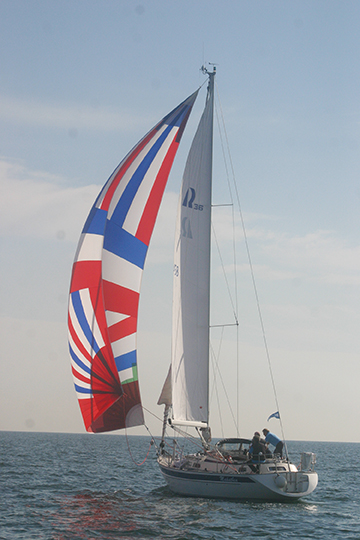 At the other end of the spectrum are the small, flat, genoa-like sails like the Code Zero. These are really big reaching genoas as much as anything else and will have shorter foot lengths at 150 to165 percent of J, the girth will be in the 55 to70 percent range, the shape will be flat and the luff projection minimal. A Code Zero’s optimum apparent wind angles will be 50 to120 degrees. The fabric weight will need to be stronger and more genoa-like as well. These sails often require specialized composite materials. Nylon has too much stretch for the loads they see at close apparent wind angles.
At the other end of the spectrum are the small, flat, genoa-like sails like the Code Zero. These are really big reaching genoas as much as anything else and will have shorter foot lengths at 150 to165 percent of J, the girth will be in the 55 to70 percent range, the shape will be flat and the luff projection minimal. A Code Zero’s optimum apparent wind angles will be 50 to120 degrees. The fabric weight will need to be stronger and more genoa-like as well. These sails often require specialized composite materials. Nylon has too much stretch for the loads they see at close apparent wind angles.
Handling systems come down to a choice between spinnaker socks and top down furling systems. Socks are simple and work well particularly on spinnakers with big girths. Top down furlers work but can struggle as the girths get bigger. They work well on smaller, flatter sails. Sails with a lot of width up high are still tough to get furled tightly and reliably. Top down furlers also need clearance between the head stay and the furled sail so a sprit really helps.
So what would my dream, no budget inventory be for downwind sailing? I’d have a big A2 runner in a sock for broad angles. For reaching, I’d have a Code Zero on a top down furler. The Code Zero would take the place of a big overlapping genoa allowing me to use a small, easily handled and more versatile headsail for upwind work. Both downwind sails would set on a sprit.
Dave Flynn is a master sailmaker with Quantum Sails and has built innovative and long lasting sails for cruisers for many years. He also has specialized in exotic performance sails for maxi racing boats.

